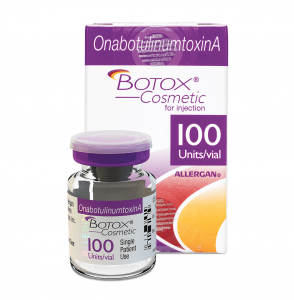
After its FDA approval in 2002 for treatment of frown lines, Botox® has become a widely recognized term and is most commonly known for its aesthetic dermatology uses like reducing fine lines and wrinkles around the eyes and forehead. However, Botox® has many FDA-approved uses that most do not realize. Read on for uses of Botox® that could be used to treat a condition you are facing.
FDA Approved Dermatologic Treatment
Excessive Sweating
In 2004, the FDA approved the use of Botox® to treat hyperhidrosis, a medical condition that causes excessive sweating. The most common areas of the body that are impacted by hyperhidrosis are the underarms, palms, feet, and head. By using Botox® to treat this condition, the chemical signal that is sent to nerve endings that stimulate sweat glands is blocked, reducing the amount of sweating. Injections will be placed into the area or areas of excessive sweating and results can last up to six months.
Common Off-Label Cosmetic Uses of Botox®
Eyebrow Lift
The main cause for a dropping eyebrow is age. Using Botox® for lifting the eyebrows is a less invasive alternative to the surgical eyebrow lift. The procedure consists of injecting Botox® into the muscles responsible for pulling the eyebrow down. Those muscles become weakened allowing the eyebrow to lift and leave the face with a more youthful expression. The treatment is quick with minimal down-time and usually lasts between three and six months.
Gummy Smile
While not medically alarming, gummy smile is when a large portion of the gums show when a person smiles. Typically, treatment is wanted when one feels self-conscious with their smile. There are many causes to gummy smile, but usually it is due to an over active muscle in the upper lip. Botox® can be injected into the upper lip to relax the muscle and reduce the amount of gum visible while smiling. The treatment is considered a “walk in, walk out” treatment, as it is non-invasive. Results can last between four to six months depending on individual cases.
Vertical Neck Lines
Many people neglect their neck when thinking about anti-aging treatments. This sometimes results in a mismatch between the look of one’s face and neck. One sign of an aging neck is vertical bands that run up and down the neck. Botox® can help to relax these bands, resulting in a smoother, less wrinkled neck. Treatments typically last four to six months.
Soften Jawline and Chin
In some people, the muscle that controls the chewing actions of the jaw, the masseter muscle, can be very large creating a more square shape of the face. Injecting Botox® into this muscle can help to soften its movement and reduce its size. By doing so, the jawline is softened and results is a more oval or heart shaped face. The treatment requires almost no down time and can be done in your provider’s office. As with other Botox® treatments, the results can take up to 2 weeks to show maximum improvement. The effects of the treatment can wear off at the 3 to 4 month mark.
Lift the Down-Turned Corners of the Mouth
Somewhat like the eyebrows, there is a tug of war with the muscles that pull up and pull down on the corners of the mouth. Therefore, if the muscles pulling the corners of the mouth down become stronger they can “win” the tug of war and the corners of the mouth will be pulled down into a resting frown. However, by injecting Botox® into the muscles that are pulling the mouth down, the muscle becomes weakened, allowing the corners to turn up and into a more natural position. Like most Botox® treatments, the procedure is an “in and out” procedure and requires little down time.
Non-Dermatologic FDA-Approved Uses for Botox®
Chronic Migraines
Chronic Migraines are characterized as having a headache 15 days out of the month. Some of the most common symptoms associated with the disorder are pulsing, throbbing pain, sensitivity to light and sound, and nausea. After a trial study, the FDA approved the use of Botox® in treating chronic migraines. Notably, the treatment doesn’t cure the migraines, but can reduce the symptoms and make them more tolerable and easier to manage. The treatment requires injections to the head and neck and results can last up to three months.
Crossed Eyes
Surprisingly, 4% of Americans suffer from Strabismus, or crossed eyes. This condition is just what it sounds like and the eyes are misaligned. Botox® can be used to correct this condition by injecting it into the eye muscles to relax them, allowing the eye to refocus and straighten. Results can last up to three or four months, but results can last longer after a few treatments.
Muscle Spasms
Botox® is approved in the US to treat muscle spasms in the eyelids, face, neck, shoulders, and upper body. Treatment prevents the release of chemical transmitters that activate the muscle. In other words, the message from the brain that tells the muscle to constrict doesn’t happen, meaning no muscle spasm. The results can last up to three months; treatment will need to be repeated as the new nerve endings grow.
While these treatments have helped many, we use Botox® to correct fine lines and wrinkles in order to provide a natural and never “overdone” look. And, as dermatologists we also treat hyperhidrosis. Please ask your other healthcare providers about treatment for non-dermatologic conditions. Take a look at our Botox® page for more valuable information on the product.
